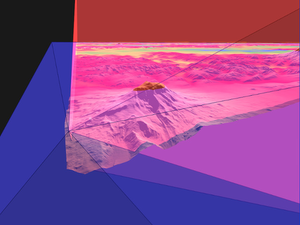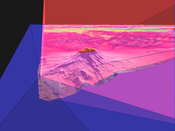Information
- Publication Type: Master Thesis
- Workgroup(s)/Project(s):
- Date: February 2020
- Date (Start): 1. January 2009
- Date (End): 7. February 2020
- TU Wien Library:
- Diploma Examination: 7. February 2020
- Open Access: yes
- First Supervisor:
Abstract
We propose a novel heightmap-based terrain rendering algorithm that enhances the Persistent Grid Mapping (PGM) method. As in the underlying method, we cache a regular triangulated grid in video memory and use the GPU to project the mesh onto the ground plane each frame anew. Each vertex in the grid is then displaced according to the sampled heightmap value along the ground plane’s normal vector. The perspective mapping of the grid results in a view-dependent, continuous level-of-detail approximation of the terrain dataset.PGM is a simple and elegant terrain rendering algorithm, however, as the camera hovers over the terrain, projected vertex positions slide over the terrain. This leads to the underlying static terrain surface changing shape slightly from frame to frame. We address these swimming artifacts by introducing four improvements: tailoring the projected grid, which pushes most otherwise culled vertices back into the view frustum, redistributing grid vertices according to an importance function for more faithful mipmap selection when sampling the heightmap, local terrain edge search for vertices within a certain proximity to the camera, and exploiting temporal coherence between frames. While our algorithm cannot guarantee a maximum screen-space error, it nevertheless reduces PGM’s inherent temporal aliasing artifacts considerably.
Additional Files and Images
Weblinks
No further information available.BibTeX
@mastersthesis{houska-2020-IPGM,
title = "Improved Persistent Grid Mapping",
author = "Peter Houska",
year = "2020",
abstract = "We propose a novel heightmap-based terrain rendering
algorithm that enhances the Persistent Grid Mapping (PGM)
method. As in the underlying method, we cache a regular
triangulated grid in video memory and use the GPU to project
the mesh onto the ground plane each frame anew. Each vertex
in the grid is then displaced according to the sampled
heightmap value along the ground plane’s normal vector.
The perspective mapping of the grid results in a
view-dependent, continuous level-of-detail approximation of
the terrain dataset. PGM is a simple and elegant terrain
rendering algorithm, however, as the camera hovers over the
terrain, projected vertex positions slide over the terrain.
This leads to the underlying static terrain surface changing
shape slightly from frame to frame. We address these
swimming artifacts by introducing four improvements:
tailoring the projected grid, which pushes most otherwise
culled vertices back into the view frustum, redistributing
grid vertices according to an importance function for more
faithful mipmap selection when sampling the heightmap, local
terrain edge search for vertices within a certain proximity
to the camera, and exploiting temporal coherence between
frames. While our algorithm cannot guarantee a maximum
screen-space error, it nevertheless reduces PGM’s inherent
temporal aliasing artifacts considerably.",
month = feb,
address = "Favoritenstrasse 9-11/E193-02, A-1040 Vienna, Austria",
school = "Research Unit of Computer Graphics, Institute of Visual
Computing and Human-Centered Technology, Faculty of
Informatics, TU Wien",
URL = "https://www.cg.tuwien.ac.at/research/publications/2020/houska-2020-IPGM/",
}

 poster
poster thesis
thesis


